SILVANA MOSSANO
Reportage udienza del 22 novembre 2021
Basta un minuscolo – tutt’altro che insignificante – segno di punteggiatura a trasformare una frase, e quindi il concetto che essa esprime, da certezza in dubbio.
La certezza: «Tutte e 392 le persone indicate nel capo di imputazione del processo Eternit Bis sono morte a causa del mesotelioma, provocato dalla fibra di amianto che hanno respirato». Questa l’affermazione espressa, con documentata sicurezza, dai consulenti della procura nell’udienza del 15 novembre scorso.
Il dubbio: «Sono – tutte e 392 – diagnosi sicure di mesotelioma?». Questo l’interrogativo sollevato, nell’udienza di lunedì 22 novembre in Corte d’Assise, dai difensori dell’imputato Stephan Schmidheiny, impegnati nel controesame dei consulenti della pubblica accusa.
Quel punto interrogativo è un punteruolo acuminato che penetra dolorosamente nella carne e nella memoria di chi ha visto morire, con sofferenza e angoscia, una persona cara per «quella» diagnosi. Magari non fosse stata «quella» la diagnosi per i 392 nomi elencati nel capo di imputazione in cui l’imprenditore svizzero è chiamato a rispondere, per tutti i casi, di omicidio volontario, con dolo eventuale.
Ma se è la giustizia che qui si invoca – come da anni sta scritto, a caratteri cubitali, sulle bandiere tricolore «ETERNIT GIUSTIZIA» -, allora l’obbiettivo va perseguito secondo le giuste regole del processo democratico, consapevoli di dover attraversare senza sconti anche i passaggi più duri.
E’ quanto sta avvenendo.
Peraltro non sorprende che gli avvocati Guido Carlo Alleva e Astolfo Di Amato, difensori di Schmidheiny, facciano quello che avevano anticipato fin dall’inizio del processo, e cioè chiedano conto con assoluto rigore della fondatezza, oltre ogni ragionevole dubbio, di ognuna delle diagnosi.
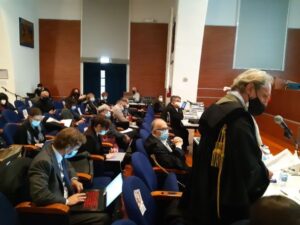
D’altronde l’accusa è pesante: omicidio volontario. Moltiplicato per 392: cioè 392 omicidi da cui difendersi.
Dunque non sorprende, dicevo, ed è legittimo che i legali Alleva e Di Amato, richiamando meticolosamente caso per caso – e talora accompagnando il nome della vittima anche con un caritatevole «la povera signora…» -, chiedano conto della veridicità incontrovertibile di quella diagnosi: è proprio mesotelioma? O era una metastasi che si è estesa alla pleura, ma sviluppata da un altro tipo di tumore non riconducibile all’amianto?
La difesa dell’imputato, forte delle tesi dei propri consulenti tecnici (che saranno sentiti più avanti), pone una delimitazione: per essere accettata come diagnosi certa di mesotelioma serve la conferma di un’analisi immunoistochimica, basata su determinati marcatori. O dentro o fuori. Senza la conferma immunoistochimica, con quegli specifici marcatori, il caso, secondo la loro posizione, è da scartare dall’elenco delle 392 vittime.
Il punto è che l’immunoistochimica è una metodologia diagnostica relativamente recente (a partire dagli anni Novanta, e che non esisteva pertanto quando si è manifestata la patologia prima di quell’epoca) e di cui, via via, si continuano ad affinare le linee guida. E quindi?
Le contestazioni da parte della difesa, che ha controesaminato i consulenti (gli anatomopatologi Donata Bellis e Narciso Mariani, e, parzialmente, Massimiliano Buggiani e Pavilio Piccioni, pneumologi, e Ferruccio Perrelli, medico del lavoro), mirano a distinguere le diagnosi tra quelle accertate con analisi immunoistochimiche e no.
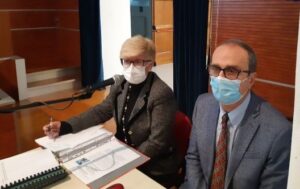
E’ così netta la linea di demarcazione? Se manca l’accertamento immunoistochimico significa che quelle vittime sono da collocare in un limbo di incertezza diagnostica e, comunque, secondo la difesa, da depennare dal processo Eternit Bis?
Bellis e Mariani hanno replicato con sicuro piglio scientifico: eh no, se l’unica, esclusiva dirimente fosse la colorazione dei vetrini con la tecnica immunoistochimica, «basterebbe una macchina che svolge questa funzione e non sarebbe necessario un anatomopatologo» ha affermato con garbo e risolutezza Donata Bellis. La diagnosi, ha spiegato, si forma e si conferma valutando e confrontando più aspetti: dalla morfologia del tumore, agli esami radiografici (rx, tac, pet), citologici e istologici, con ulteriore, se ritenuta necessaria dagli esperti, riverifica tramite l’immunoistochimica.
I difensori, dimostrando di conoscere bene ciascuna cartella clinica, hanno richiamato anche situazioni apparentemente uguali per le quali, però, gli anatomopatologi hanno seguito percorsi diagnostici differenti per arrivare alla diagnosi. La spiegazione dei consulenti: «Si valuta caso per caso che cosa è necessario per trovare o escludere la conferma».
Altro aspetto: sono stati richiamati alcuni casi cui, anni prima, era stato diagnosticato un tumore diverso (ad esempio all’intestino), curato e dal quale, trascorso un certo periodo codificato, era stata dichiarata la guarigione. Successivamente, è comparso il versamento pleurico. Anziché di mesotelioma, non avrebbe potuto trattarsi di metastasi sviluppate dalla precedente neoplasia? Effettivamente è la prima ragionevole ipotesi, ma è poi l’anatomopatologo, proprio raffrontando tutti i risultati, che fornisce una risposta certa. E se il nome della vittima ora compare tra i 392 è perché i consulenti del pm hanno confermato la diagnosi di mesotelioma. Si aggiunga anche che, ovunque, con l’aumento della sopravvivenza per un primo tumore, l’evenienza della comparsa, nella stessa persona, di due tumori diversi in tempi diversi diventa meno rara.
Altra situazione evidenziata riguardava un uomo che ha lavorato all’Eternit per un tempo brevissimo da quando Schmidheiny assunse la gestione nel 1976; come si può ricondurre all’imputato quel caso di mesotelioma, limitato a un’esposizione lavorativa di un paio di settimane? La storia ha però messo in luce che il paziente è vissuto a Casale e che, indipendentemente dalla cortissima parentesi professionale, rientra tra i cosiddetti (molti) «casi ambientali»: diversa l’occasione di esposizione all’amianto, ma identico il tumore.
ECCEZIONE RESPINTA
Che la fondatezza inoppugnabile e puntuale di ogni diagnosi rappresenti il cuore del processo Eternit Bis lo dimostra anche la rigorosa attenzione che i legali Di Amato e Alleva riservano all’utilizzo e all’accesso del materiale organico (i cosiddetti «vetrini» e «blocchetti» di tessuto prelevato, a suo tempo, dai pazienti con la biopsia), visionato e analizzato dai consulenti della procura per svolgere le loro relazioni. «I nostri consulenti, invece, non sono stati messi nella condizione di accedervi per esaminarli allo stesso modo» avevano lamentato già a luglio, sollevando un’eccezione di nullità che la Corte, presieduta da Gianfranco Pezone (affiancato da Manuela Massino e dai sei giudici popolari), aveva respinto, invitando procura e difesa ad accordarsi perché quei materiali organici, custoditi presso la procura della Repubblica di Torino, fossero accessibili (pur con tutte le cautele di sicurezza necessarie a tutelare ciò che rappresenta il corpo di reato). La questione era tornata a galla lunedì 15 novembre, in occasione della prima disamina degli anatomopatologi che, illustrando la loro relazione, avevano fatto riferimento agli accertamenti da loro svolti proprio su quei vetrini.
«Quel che esce dalla porta non può rientrare dalla finestra» aveva lamentato l’avvocato Alleva, sollevando, questa volta, eccezione di inutilizzabilità. I pm Gianfranco Colace e Mariagiovanna Compare hanno replicato ribadendo non c’è mai stata preclusione nel mettere a disposizione quei materiali.
La Corte, esaminata la questione, ha respinto l’eccezione, ammettendo, sì, «disguidi, malintesi e scarsa collaborazione reciproca» tra procura e difesa, «ma non c’è stata volontà negativa da parte dei pm» ha detto il presidente Pezone leggendo l’ordinanza.
Tra l’altro, da luglio a ora, il professor Massimo Roncalli, anatomopatologo consulente della difesa, si è accordato e ha installato due microscopi nei locali della procura torinese procedendo e progredendo con gli accertamenti ritenuti necessari. Pare che il lavoro di analisi sia a buon punto.
PROSSIME UDIENZE
Lunedì 28 novembre saranno esaminati altri tre consulenti della procura: gli epidemiologi Corrado Magnani e Dario Mirabelli, e la genetista Irma Dianzani.
Il 6 dicembre toccherà ai consulenti indicati dalla parte civile avvocato Laura D’Amico: l’anatomopatologo Mauro Papotti, già al San Luigi di Orbassano e ora alle Molinette, e il medico del lavoro Pietro Gino Barbieri.
Il 13 dicembre, la difesa conclude il controesame dei consulenti Buggiani, Piccioni e Perrelli, e procede con il controesame di Magnani, Mirabelli e Dianzani.
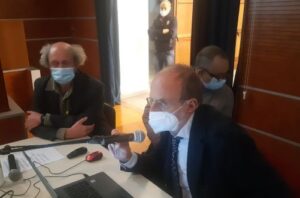
L’ultima udienza prima di Natale è il 20 dicembre.
Traduzione di Vicky Franzinetti
Translation by Vicky Franzinetti
November the 22nd, 2021 Eternit hearing
By Silvana MOSSANO
All it takes is a tiny – albeit significant – comma or other punctuation mark to change a sentence, and hence the concept it enshrines, turning it from a certain into a doubtful statement.
Certainty: “All 392 persons named in the charges listed against the defendants in the Eternit Bis trial died of mesothelioma, caused by the asbestos fibres they breathed in”. This is the statement expressed by the prosecutor’s experts at the hearing on 15 November with documented certainty.
Doubt: “Are all the 392 cases certain diagnoses of mesothelioma?”. This was the question raised at the hearing on Monday, 22 November in the Assize Court by the defence, that is by Stephan Schmidheiny lawyers, who were cross-examining the prosecution’s expert witnesses.
That question mark is like a sharp dagger painfully penetrating the flesh and memory of those who have seen a loved one die, with suffering and anguish, because of “that” diagnosis. If only it had not been “that” diagnosis for the 392 names listed for which the Swiss businessman is called to answer, for all cases, of voluntary homicide, with possible wilfulness. If it is justice that is being invoked here – as has been written for years, in large letters, on the Italian flags “ETERNIT GIUSTIZIA” – then we must follow the rules of the trial, aware that we will have to bear even the hardest passages, no discounts on the bill to pay.
And this is what is happening. Moreover, it is not surprising that Guido Carlo Alleva and Astolfo Di Amato, Schmidheiny’s defence lawyers, are doing what they had stated ever since the beginning of the trial, i.e. they are asking for an absolutely rigorous account of the validity, beyond all reasonable doubt, of each diagnosis.
On the other hand, the indictment is not joke: voluntary murder. Multiplied by 392: that is, 392 murders to defend. So as I was saying it is not surprising it is legitimate that Alleva and Di Amato, meticulously recalling case by case – and sometimes accompanying the name of the victim with a charitable “the poor woman…” -, asking for an account of the truthfulness of the charges. -, ask for an account of an unquestionable diagnosis: is it really mesothelioma? Or was it a metastasis that spread to the pleura, but developed from another type of tumour not attributable to asbestos? On the strength of the arguments of its expert witnesses (who will be heard later in the trial), the defence raised another matter: in order to be accepted as a definite diagnosis of mesothelioma, confirmation of an immunohistochemical analysis, based on certain markers, is required. Without immunohistochemical confirmation, with those specific markers, the case, according to their position, is to be removed from the list of 392 victims. The point is that immunohistochemistry is a relatively recent diagnostic methodology (starting in the 1990s, and therefore did not exist when the disease occurred before that time) and whose guidelines continue to be refined over time. So?
The objections of the defence as it cross-examined the PP’s expert witnesses (pathologists Drs Donata Bellis and Narciso Mariani, and, to a degree , Massimiliano Buggiani and Pavilio Piccioni, pneumologists, and Ferruccio Perrelli, occupational physician), aim to group the diagnoses into those established by immunohistochemical tests and those that have no such test.
Is the dividing line clear? Does the lack of immunohistochemical tests mean that those victims are to be placed in a limbo of diagnostic uncertainty and, in any case, according to the defence, to be removed from the Eternit Bis trial? Drs Bellis and Mariani replied with a certain scientific panache: no, if the only excluding decisive factor was the staining of the slides with the immunohistochemistry, “a machine that performs this function would be sufficient and there would be no need for an pathologist“, Donata Bellis stated with politeness and determination. The diagnosis, Bellis added, is formed and confirmed by evaluating and comparing several aspects: from the morphology of the tumour, to the radiographic (X-ray, CT, PET), cytological and histological tests, with further, verification through immunohistochemistry if the specialists deem it necessary. The defence lawyer also referred to apparently identical situations for which, however, the pathologists followed different paths to diagnose, showing that they were familiar with each medical file. The expert witnesses’ explanation: ‘We evaluate case by case what is necessary to find or exclude confirmation’.
Another issue: some of the victims had had another tumour (e.g. of the intestine) diagnosed years before treated and from which, after a certain codified period, the patient had been declared in remission or even cured. Subsequently, a pleural effusion appeared. Instead of mesothelioma, could it not have been metastases developed from the previous neoplasm? Indeed, this is the first reasonable hypothesis, but it is then the anatomical pathologist, who provides a definite answer by comparing all the results. If the victim’s name now appears among the 392 it is because the prosecutor’s experts confirmed the mesothelioma diagnosis. Furthermore, while survival rates for a first tumour increase, the occurrence of two different tumours appearing at different times in the same person is not so common. Another case concerned a man who had worked at Eternit for a very short time since Schmidheiny took over in 1976; how can that case of mesothelioma, limited to a work exposure of a couple of weeks, be traced back to the defendant? History has shown, however, that the patient lived in Casale and that, regardless of the very short professional exposure, he is one of the so-called (many) “environmental cases”: the occasion of exposure to asbestos is different, but the tumour is identical.
OBJECTIONS
The fact that the unquestionable and detailed diagnosis represents is the heart of the Eternit Bis trial is also shown by the rigorous attention paid by the lawyers Di Amato and Alleva to the use and access to the organic material (the so-called “slides” and “blocks” of tissue taken, at the time, from the patients with the biopsy), viewed and analysed by the prosecutor’s experts. “Our experts were not given access to them to examine them in the same way“, they had already complained in July, raising an objection of nullity that the Court, presided over by Dr Gianfranco Pezone (as well as by Dr Manuela Massino and the six members of the jury aka popular judges), had rejected, inviting the prosecution and the defence to agree so that the organic materials, stored at the Turin Public Prosecutor’s Office, could be accessed albeit with all the necessary security precautions to protect crime evidence. The objection was raised again on Monday the 15th of November, when pathologists were first hears as in their report they had referred to the investigations they had carried out on the slides.
“It can’t come back through the back door,” complained defence lawyer Alleva, raising an objection referred to the fact they maintained they had not been able to access. Prosecutors Gianfranco Colace and Mariagiovanna Compare replied that there had never been precluded in any manner in making those materials available. Having considered the objection , the Court, rejected it , stating there had been “misunderstandings and poor mutual cooperation” between the Prosecution and Defence, “but there was no negative intention on the part of the Prosecutors,” said President Pezone rejecting the objection.
Since Professor Massimo Roncalli, the defence’s expert agreed and installed two microscopes in the Turin prosecutor’s office, proceeding and progressing with the investigations deemed necessary. It seems that his work is well underway.
NEXT HEARINGS
On Monday 28 November, three other prosecution consultants will be examined: epidemiologists Drs Corrado Magnani and Dario Mirabelli, and geneticist Prof Irma Dianzani.
On the 6th of December it will be the turn of the experts listed by the plaintiffs’ lawyer Laura D’Amico: the Dr Mauro Papotti (pathologist formerly at San Luigi Orbassano Hospital, now at the Turin Molinette Hospital, and the occupational physician Pietro Gino Barbieri.
On December the 13th , the defence will cross examine consultants Buggiani, Piccioni and Perrelli, and Magnani, Mirabelli and Dianzani.
The last hearing before Christmas will be on December the 20th 2021.

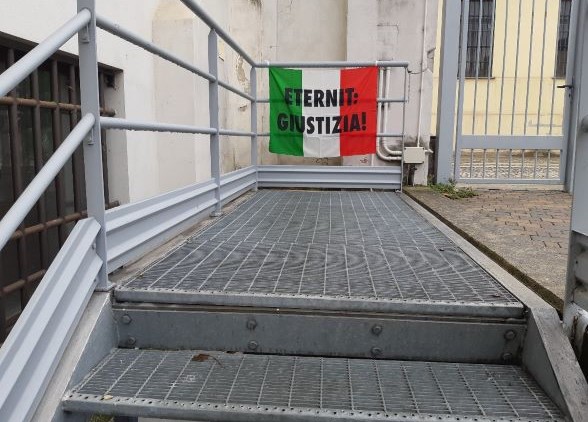
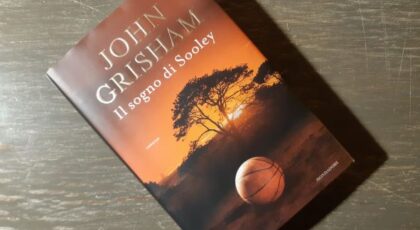
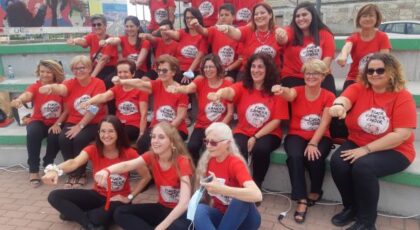
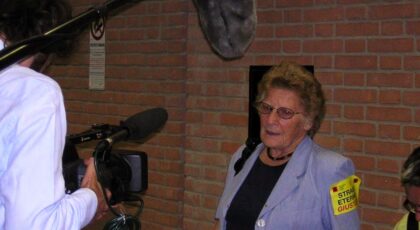
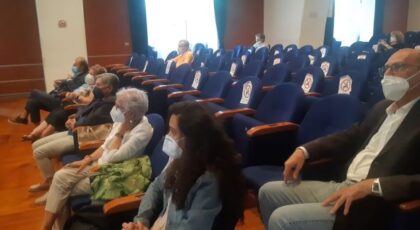
Sempre più intricato è dibattuto il caso. Sarà lunga . Auguriamoci positiva per chi da anni lotta per la Giustizia .